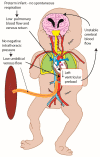Neonatal Resuscitation with an Intact Cord: Current and Ongoing Trials
- PMID: 31013574
- PMCID: PMC6517946
- DOI: 10.3390/children6040060
Neonatal Resuscitation with an Intact Cord: Current and Ongoing Trials
Erratum in
-
Correction: Anup C. Katheria. Neonatal Resuscitation with an Intact Cord: Current and Ongoing Trials. Children 2019, 6, 60.Children (Basel). 2019 May 21;6(5):71. doi: 10.3390/children6050071. Children (Basel). 2019. PMID: 31117230 Free PMC article.
Abstract
Premature and full-term infants are at high risk of morbidities such as intraventricular hemorrhage or hypoxic-ischemic encephalopathy. The sickest infants at birth are the most likely to die and or develop intraventricular hemorrhage. Delayed cord clamping has been shown to reduce these morbidities, but is currently not provided to those infants that need immediate resuscitation. This review will discuss recently published and ongoing or planned clinical trials involving neonatal resuscitation while the newborn is still attached to the umbilical cord. We will discuss the implications on neonatal management and delivery room care should this method become standard practice. We will review previous and ongoing trials that provided respiratory support compared to no support. Lastly, we will discuss the implications of implementing routine resuscitation support outside of a research setting.
Keywords: delayed cord clamping; newborn; premature infants; resuscitation.
Conflict of interest statement
The authors declare no conflict of interest.
Figures
References
Publication types
LinkOut - more resources
Full Text Sources
Medical


